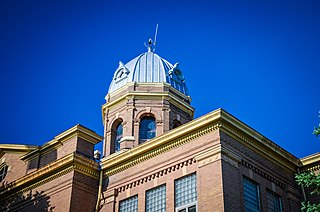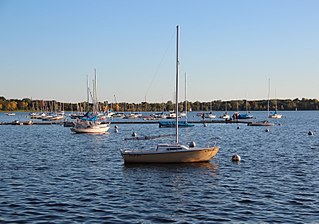
The Sioux or Oceti Sakowin are groups of Native American tribes and First Nations peoples in North America. The term is an exonym created from a French transcription of the Anishinaabe term "Nadouessioux", and can refer to any ethnic group within the Great Sioux Nation or to any of the nation's many language dialects. The modern Sioux consist of two major divisions based on language divisions: the Dakota and Lakota.

Roberts County is a county in the U.S. state of South Dakota. As of the 2010 United States Census, the population was 10,149. Its county seat is Sisseton. The county was named either for S. G. Roberts of Fargo, North Dakota, or for Solomon Robar, an early local French fur trader. It was created on March 8, 1883, and fully organized by August 6 of that year. Its boundary was altered once, in 1885.

Nobles County is a county in the U.S. state of Minnesota. As of the 2010 United States Census, the population was 21,378. Its county seat is Worthington.

Fairmont is a city in and the county seat of Martin County, Minnesota, United States. The population was 10,666 at the 2010 census.

Sisseton is a city in Roberts County, South Dakota, United States. The population was 2,470 at the 2010 census. It is the county seat of Roberts County. Sisseton is home to a number of attractions, including the Nicollet Tower, and is near the "Song to the Great Spirit" building on the Sisseton Wahpeton College campus. The city is named for the Sisseton division of the Native American Sioux.

Joseph Nicolas Nicollet, also known as Jean-Nicolas Nicollet, was a French geographer, astronomer, and mathematician known for mapping the Upper Mississippi River basin during the 1830s. Nicollet led three expeditions in the region between the Mississippi and Missouri Rivers, primarily in Minnesota, South Dakota, and North Dakota.

Bde Maka Ska is the largest lake in Minneapolis, Minnesota, United States, and part of the city's Chain of Lakes. Surrounded by city park land and circled by bike and walking trails, it is popular for many outdoor activities. The lake has an area of 401 acres (1.62 km2) and a maximum depth of 87 feet (27 m).

South Dakota Highway 10 (SD 10) is a 175.945-mile (283.156 km) state highway in the north-central and northeastern portions of South Dakota, United States. It connects SD 1804 in Pollock with the Minnesota state line southeast of Sisseton.

Ishtakhaba, also known as Chief Sleepy Eyes, was a Native American chief of the Sisseton Dakota tribe. He became chief sometime between 1822 and 1825, receiving a commission from the Bureau of Indian Affairs as chief in 1824, and remained chief until his death in 1860. His band, known as the Swan Lake or Little Rock Band, hunted "in southwestern Minnesota and southeastern Dakota ... between Swan Lake and Coteau des Prairies," until forced to move to reservation land near the Minnesota River in the wake of the 1857 Spirit Lake Massacre.
Mdewakantonwan are one of the sub-tribes of the Isanti (Santee) Dakota (Sioux). Their historic home is Mille Lacs Lake in central Minnesota, which in the Dakota language was called Mde wakan. Together with the Wahpekute, they form the so-called Upper Council of the Dakota or Santee Sioux.

Agency Village is an unincorporated census-designated place in Roberts County, South Dakota, United States. It is the headquarters of the Sisseton Wahpeton Oyate and home to Sisseton Wahpeton College. The village hosts a number of powwows, one of which is held annually just before Independence Day. This outdoor powwow draws a large number of tourists to the area. The community is primarily made up of members of the tribe.

The Spirit Lake Tribe is a federally recognized tribe based on the Spirit Lake Dakota Reservation located in east-central North Dakota on the southern shores of Devils Lake. It is made up of people of the Pabaksa (Iháŋkthuŋwaŋna), Sisseton (Sisíthuŋwaŋ) and Wahpeton (Waȟpéthuŋwaŋ) bands of the Dakota tribe. Established in 1867 in a treaty between Sisseton-Wahpeton Bands and the United States government, the reservation, at 47°54′38″N98°53′01″W, consists of 1,283.777 square kilometres (495.669 sq mi) of land area, primarily in Benson and Eddy counties. Smaller areas extend into Ramsey, Wells and Nelson counties.

The Lake Traverse Indian Reservation is the homeland of the Sisseton Wahpeton Oyate, a branch of the Santee Dakota group of Native Americans. Most of the reservation covers parts of five counties in northeastern South Dakota, while smaller parts are in two counties in southeastern North Dakota, United States. Its resident population of 10,408 persons was counted during the 2000 census. About one-third of its inhabitants claim to be of solely Native American heritage. Its largest community is the city of Sisseton, South Dakota.

The Treaty of Traverse des Sioux was signed on July 23, 1851, at Traverse des Sioux in Minnesota Territory between the United States government and Sioux Indian bands in Minnesota Territory. By this treaty, the Sioux ceded large tracts of territory and agreed to move on to reservations along the Minnesota River in exchange for annuities of cash and goods.

The Dakota are a Native American tribe and First Nations band government in North America. They compose two of the three main subcultures of the Sioux people, and are typically divided into the Eastern Dakota and the Western Dakota.
Gabriel Renville was Chief of the Sisseton Wahpeton Oyate Sioux Tribe from 1866 until his death in 1892. As part of a large fur-trader family of French and Sioux origins, he was an unlikely candidate for Chief of the Sisseton Wahpeton Oyate. However, with the coming of the Dakota War of 1862, his fortunes changed. Thanks to his family's connections, he obtained in 1863 the post of Chief of Scouts in the service of Minnesota state militia Colonel Henry Hastings Sibley--later to become the first governor of the state of Minnesota. His service to the U.S. Army ended in 1865. For his military service, he was appointed by Sibley as Chief of the Sisseton Wahpeton Oyate in 1866. His people seconded Sibley's appointment a year later by declaring Renville chief-for-life. His tenure as chief saw the creation and settlement of his people on the Lake Traverse Reservation. He is buried atop a bluff near Old Agency, South Dakota.

The Sisseton Wahpeton Oyate of the Lake Traverse Reservation, formerly Sisseton-Wahpeton Sioux Tribe/Dakota Nation, is a federally recognized tribe comprising two bands and two subdivisions of the Isanti or Santee Dakota people. They are on the Lake Traverse Reservation in northeast South Dakota.

Agency Township is a township in Roberts County, South Dakota, United States. The township is part of the Lake Traverse Reservation, which is home to the Sisseton Wahpeton Oyate Indian tribe. The tribe's headquarters at Agency Village are in the township, as is Sisseton Wahpeton College.
Dakota Rail, Inc. was a short-line railroad which operated in South Dakota and Minnesota. It operated from 1982 until 2001. From 1995 onward it was a subsidiary of RailAmerica.
Sixmile Lake is a lake in South Dakota, in the United States.















